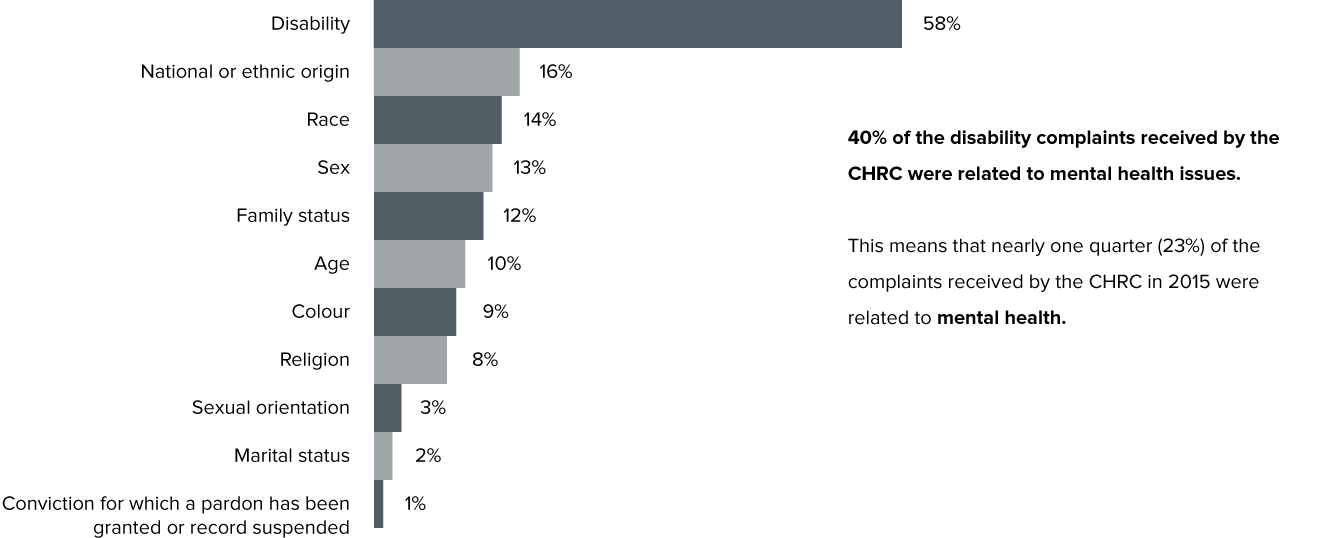Statistics
In any given year, the Canadian Human Rights Commission helps thousands of people determine whether they have a valid human rights complaint. In many cases, the Commission helps people resolve their issues quickly and informally, or find the appropriate process to resolve their concerns.
Only a fraction of the people who contact the Commission file a formal discrimination complaint.
The statistics below report on formal written complaints handled by the Commission in 2015.
By law, the Commission must consider every written discrimination complaint it receives. The Commission can decide not to deal with the complaint or refer it to an alternative dispute resolution mechanism. When possible, the Commission encourages people to try to resolve their disputes informally and at the earliest opportunity. In the event no agreement is reached, the Commission may conduct an investigation. When warranted, the Commission refers the case to the Canadian Human Rights Tribunal for a hearing.
2015
Complaints filed with the CHRC
1 A received complaint, also known as a potential complaint, is a contact that falls within the mandate of the Canadian Human Rights Commission (CHRC), and that may lead to an accepted complaint after analysis and review.
2 An accepted complaint is a document, in a form acceptable to the CHRC, that is filed by an individual or group of individuals having reasonable grounds for believing that a person or organization is engaging or has engaged in a discriminatory practice.
3 The number of complaints referred to another redress process includes those that were referred to the Public Service Labour Relations Board or the Public Service Staffing Tribunal before they became accepted complaints.
4 The CHRC can decide not to deal with complaints that do not meet the criteria listed under subsections 41(1) (c,d,e) of the Canadian Human Rights Act (e.g. the complaint fell outside of the CHRC’s jurisdiction or the complaint was frivolous, vexatious or made in bad faith.)
Employment equity audits
In 2015, the Canadian Human Rights Commission conducted compliance reviews with a focus on ensuring progress towards equality in the workplace:
- The Commission produced audit reports for 41 federally regulated employers. These reports acknowledged the actions these employers have taken to fulfill their employment equity obligations.
- The Commission issued 48 status reports for employers that achieved good employment equity results in their industry sectors. The status reports also flag outstanding challenges facing these employers.
- The Commission negotiated agreements with 43 employers that were not in compliance with the Employment Equity Act. Each agreement outlined actions that the employer would take to improve their employment equity performance.
Figure 1
Complaints received by province or territory (2015)
Figure 21
Complaints received by province or territory
The percentages may not add up to 100% due to rounding.
Figure 32
Complaints received by types of respondents
The percentages may not add up to 100% due to rounding.
*Includes employers in the core public administration, separate federal government organizations or agencies, and Crown corporations.
Figure 43
Complaints received by types of allegation cited
The percentages may not add up to 100% due to rounding.
Total number of allegations cited exceeds the total number of received complaints because some complaints dealt with more than one allegation.
Figure 54
Complaints accepted by province or territory
The percentages may not add up to 100% due to rounding.
-- Indicates that the data has been withheld to protect confidentiality.
Figure 65
Complaints accepted by types of respondents
The percentages may not add up to 100% due to rounding.
*Includes employers in the core public administration, separate federal government organizations or agencies, and Crown corporations.
Figure 76
Complaints accepted by types of allegation cited
The percentages may not add up to 100% due to rounding.
Total number of allegations cited exceeds the total number of received complaints because some complaints dealt with more than one allegation.
Figure 87
Final decisions by type
* Under section 40/41 of the Canadian Human Rights Act, the CHRC may decide not to deal with a complaint because the complainant ought to pursue another redress mechanism, the incident occurred too long ago, or because the complaint is out of jurisdiction, or considered trivial, frivolous or vexatious.
** Total number of settlements includes all settlements reached between parties, with or without help from the CHRC.
Figure 98
Proportion of complaints received in 2015 by ground of discrimination
NOTE: In this graph, the total exceeds 100% because some complaints cite more than one ground.

